The U.S. Air Force has awarded Boeing a nearly $1.2 billion contract to build the first lot of eight F-15EX advanced fighter jets.
The award also covers support and one-time, upfront engineering costs. Already under construction at the Boeing F-15 production facility in St. Louis, the first two jets will be delivered next year.
The U.S. Air Force is also announcing the overall Indefinite Delivery Indefinite Quantity contract with a ceiling value of nearly $23 billion for F-15EX.
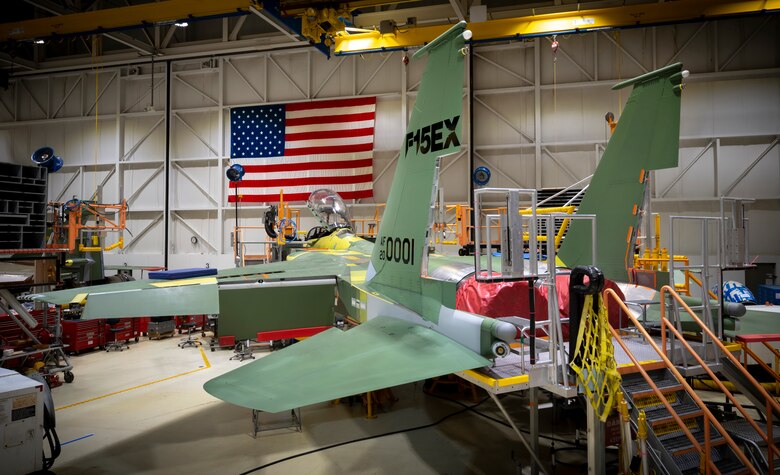
“The F-15EX is the most advanced version of the F-15 ever built, due in large part to its digital backbone,” said Lori Schneider, Boeing F-15EX programme manager.
The most significant difference between the F-15EX and legacy F-15s lies in its Open Mission Systems (OMS) architecture say the U.S. Air Force. The OMS architecture will enable the “rapid insertion of the latest aircraft technologies”. The F-15EX will also have fly-by-wire flight controls, a new electronic warfare system, advanced cockpit systems, and the latest mission systems and software capabilities available for legacy F-15s.
Pilots and mechanics currently operating the F-15 anticipate transitioning to the F-15EX in a matter of days as opposed to years. Future plans call for as many as 144 aircraft, say Boeing.



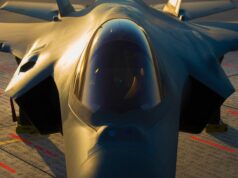

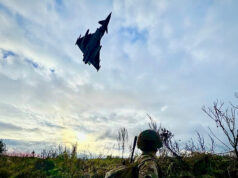
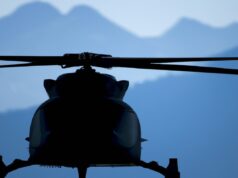
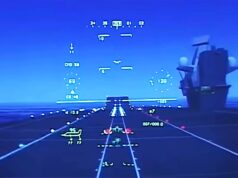
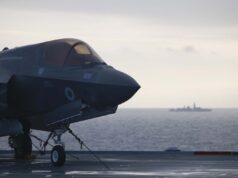

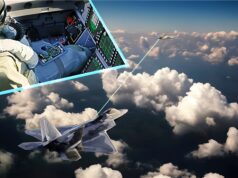
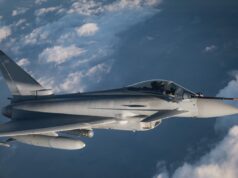
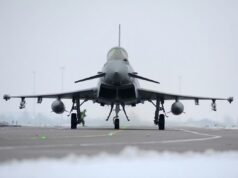

After the USAF initially rejected the idea of a modern F15, they really didn’t have a choice. Faced with the enormous costs of restarting the F22 production line, the F15X was literally their best option. Especially as LM would have had to set up a plant as their current one is pushing out F35s. There was also a big push to replace the F15s with F35s but the Senate and lot within the Air Force put a stop to this. Realistically the F35 is not an air dominance fighter. For the USAF this problem has been snowballing and shouldn’t have come as a shock or an urgent requirement. They have less than 200 F22s and a seriously aging fleet of F15C/Ds. So the issue of a F15 replacement should have been in hand. Pity we never offered them Typhoon!
A lot of the upgrades for the F15EX are based on the F15 that Qatar are getting, including the stronger F15E wing. No aerodynamic improvements, just systems, shame, they could have included some of the Quiet Eagle modifications.
Perhaps we should learn a lesson from this and keep iterating on the Typhoon, not least for combat mass. So perhaps a small amount of Tempests backed by a mass of less advanced Typhoons.
I always liked the F15 Silent Eagle. Makes me wonder how feasible it would be to produce a Silent Typhoon.
I know it wouldn’t happen due to budget and focus on F35 and Tempest, but I wonder if it could be done.
Yes, it could be done, but would require some heavy modifications to parts of the structure and probably be exorbitantly expensive. The F15SE was designed to counter X-band radar only. This simplifies how and what you can do to lower the aircraft’s radar cross section (RCS). The Typhoon already has several features to lower its RCS from the frontal aspect compared to something like an F18. Such as the flight control software aligning the canards and flight controls to a radar, swept back leading edges and RAM in the engine inlets along with serpentine inlet ducts to shield the two engine’s compressors.
So as a theory exercise, what modifications can be done to a Typhoon to reduce its RCS?
Firstly, and perhaps the quickest method of reducing the aircraft’s RCS, is to consider the aircraft’s outer skin. It will be far easier and more affordable to coat the aircraft’s skin using a “painted on” RAM. To combat an enemy’s radar, the RAM must be manufactured that attenuates the signal and minimizes any reflections. However, radars come in all shapes and sizes and use a plethora of different frequencies. Like the F15SE, it is perhaps more prudent for the Typhoon to target specific frequencies. If we consider the old-style ferrite RAM, this contained tiny metal particles or strips cut to ¼ and smaller wavelengths of specific radars. X band radar ranges from 8 to 12GHz this is a wavelength of 3.75 to 2.5cm, therefore a quarter wavelength is 0.9375cm to 0.625cm, thus making these strips of material easy-ish to suspend in a paint. The ferrite material was used predominantly in the 60’s to coat the U2 and SR71 variants. However, most active anti-aircraft missiles today are now using upper frequency X band, Ku band (12 to 18GHz = 2.5cm to 1.67cm) or Ka band (25 to 40GHz = 1.11cm to 0.75cm) due to the fixed limitation of the missile body’s diameter dictating the available antenna size. As most fighters carry an X band radar, it makes sense to use a material designed to counter this band. Because of the significantly smaller wavelengths used by air to air missile active seekers, it would be easier to use a RAM that counters all three threat bands. If we started to look at the longer wavelength bands it gets significantly more difficult, especially below the C band (4 to 8GHz = 7.5 to 3.75cm or at a ¼ = 1.875 to 0.9375cm). As the particles/strips need to be longer and making them harder to apply in a paint. To counter these lower bands, you really need to look at internal structural attenuation baffles (much like those found in the leading edges and chines of the SR71). But trying to introduce these to an already mature design would be exceedingly difficult. By coating the whole airframe in a RAM coating will have the most dramatic effect on lowering the aircraft’s RCS.
The second area of investigation to lower the aircraft’s RCS, is to consider its construction. The aircraft’s skin and fuselage use a combination of aluminium-lithium alloys and composites such as carbon-fibre. The aircraft’s skin is predominantly carbon-fibre, which on its own is not a great radar attenuator, where at certain frequencies it is transparent. Its ability to absorb RF can be improved by including RAM in the material’s weave and resin. This then would require the current aircraft’s skin to be replaced with the built in RAM, which would not be cheap. Also, lot of the joints between panels are straight butt joints, secured by countersunk screws, rivets or bonded. These long but narrow cavities will cause resonance when hit by certain frequencies of RF. To counteract this the cavity and panel joints require a sawtooth pattern. This minimizes the “antenna” length of the cavity (in simple terms). The sawtooth patterning would also need to be done to all access panels and the undercarriage doors. Realistically it also needs doing around the canopy. The methods used to fix the panels will need covering with RAM as these interact with the high K band frequencies.
The third aspect to look at is the aircraft’s fin. One of the original designs had twin canted fins. These would have helped reduce the aircraft’s RCS, especially from the sides. Having twin fins offers significant advantages over a single fin, especially if they are all moving, rather than incorporating a rudder. If the aircraft were given a pair of canted fins it would lower the aircraft’s side RCS. If they were made all moving, then the actual surface area, i.e. size could be reduced. But more importantly for reducing the RCS, you have now got rid of the 90° gap/join in the fin for the rudder. Included in this would be a redesign of the RAM air heat exchanger inlet. This would need a RAM cover on the sides to shield it, but also a lower RCS redesigned inlet.
The fourth option to look at are the two engine exhausts. A lovely round shape, complete with a clear view of the after-burner grids and power turbines are brilliant for bouncing RF. The returned doppler signature from these can be used to identify the aircraft. Eurojet have already shown and produced a thrust vectoring nozzle (TVN) exhaust. Thrust vectoring especially when used differentially can be used to minimize the amount of deflection a flying control surface needs to make. By minimizing the deflection, you are lessening the amount of surface and especially the sides exposed to RF, thus minimizing the aircraft’s RCS. Aerodynamically, thrust vectoring has additional benefits for short take-off and landing but can also increase the service ceiling of an aircraft. This is because due to the lower air density at altitude more control surface deflection is required to manoeuvre the aircraft. There will be a point where the control surfaces are no longer effective. This is where differential thrust vectoring helps by taking over from the control surfaces. However, the Eurojet thrust vectoring nozzle is round, not great for RCS. As used on the F22 and YF23, the letter box style of exhaust is what’s required for a lower RCS profile. This would mean a redesign of the Typhoon’s back end to blend in the letter box style of exhaust nozzle. The flatter profile also helps with lowering the IR signature, by fanning out the exhaust plume. The Eurojet TVN would still be a quicker and good option for lowering the aircraft’s RCS. If the flight control computer uses them in combination with the flying control surfaces, additional flight control benefits can be included.
The fifth part of lowering the aircraft’s RCS would be to remove the semi-recessed missiles. These lower the frontal RCS, but because AMRAAM or Meteor have cruciform flying controls these make nice 90°reflective surfaces seen from the sides. Like the F15SE, I would incorporate conformal weapons bays (CWB) between the underside of the wing and the engine inlet structure/lower fuselage. The CWB would also help blend in this side of the aircraft again lowering the RCS, but also decrease the aircraft’s wave drag caused by the meeting of the two surfaces. This will increase the fuel efficiency and slightly raise the aircraft’s speed.
The sixth area to consider is around the engine intakes, the splitter and side air vents. A lot of modern aircraft are now using the diverterless intake “bump”. These are great at hiding the front face of the compressor. However, they limit the maximum attainable speed of the aircraft to below Mach 2. The Typhoon’s current arrangement will allow the aircraft to reach Mach 2.3+. Therefore, to keep the speed a new inlet arrangement would be required to remove the boundary layer but in a stealthy package. Perhaps along the lines of the YF23, where panels of small holes would suck in the boundary layer, so it doesn’t go into the intake.
For the seventh, there has always been the statement that canards are no good for RCS. Well, that’s partially true, it all depends on the material used and how it’s connected to the airframe. The Typhoon uses a carbon-fibre material for the canards skin. But the leading and trailing edges are made from a lithium-aluminium alloy, these are good radar reflectors. To some extent this also include the two wing leading edges as well as the fin’s. The problem a lot of high-speed fighter aircraft have is leading edge erosion caused by dust particles in the air, hence the use of a metal as it is more resistant. To fix the RCS issue with the canards, wings and fin, the leading edges could be replaced with a composite material and coated in RAM. But with the knowledge that they would require more maintenance as the leading edges will erode quicker. As already mention carbon-fibre can appear transparent to certain RF frequencies. Inside the canard is a large metal actuator. If the canard like the rest of the aircraft is coated in RAM, RF will no longer be able to reflect off the actuator.
The eighth thought for lowering the aircraft’s RCS, would be an additional aerodynamic structure added to the aircraft. This would be the leading-edge root extensions (LERX) that have already been developed by Airbus as part of the aerodynamic modification kit (AMK). The kit significantly enhances the aircraft’s manoeuvrability. The kit also includes new side fuselage strakes with elongated flaperons and ailerons. However, by adding the LERX from the wing’s leading-edge joint to near the front of the engine inlet, you have now broken up the inlet’s flat side surface. Therefore, if the LERX was coated with RAM this would also add to lowering the aircraft’s RCS as seen from the sides.
Perhaps as a ninth consideration would be how the weapons are mounted on the wings. Traditionally, these are hung on under-wing hard-point pylons. However, these are fitted 90° to the wing’s surface creating a really good reflector. Then you hang a weapon from it, with perhaps a launch rail, when invariably the weapon itself has a cruciform tail. These are all very bad for the aircraft’s RCS. To counter this, the hard-point pylons would need a coating of RAM. Then there’s the problem with the attached weapons. A long time ago BAe showed a design of stealthy containers that could be attached to the hardpoints that missiles could be fitted in. By using these the aircraft’s RCS can be minimized.
There is one remaining “tenth” option of lowering the aircraft’s RCS. This is the tubular joint between the fuselage and the wings. If the CWB is included, this helps fix the underside of the aircraft. However, the upper would need a lot of modification. The rounded shape does not help, tubular structures create RF hotspots and just like wing tips leads to Rayleigh scattering. This is one of the reasons why when you look at a fifth-generation fighter, the upper and lower fuselage is flattened and then blended where it meets the wings. Without redesigning this section there is little more that can be done. If the fuselage is redesigned the aircraft by this point will no longer look like a Typhoon, but a completely different aircraft!
To conclude, the answer to your question is yes, the Typhoon’s RCS can be lowered and depending on funds, significantly!
The easiest method of reducing its RCS is by coating the skin in a RAM paint, after that the cost starts ramping up. For me, the best cost versus benefit options would be the following:
1. RAM paint,
2. Eurojet TVN,
3. LERX (plus the complete AMK),
4. Composite leading edges,
5. RAM pylons and containers. This is also a relatively cheap solution and isn’t really part of the aircraft’s structure.
Impressive response!
I always enjoy reading something written well, full of technical information and no grammatical errors. Good stuff!
This is a good idea to use the EX as a bomb and missile truck targeted by the F35 sensors (or other sources) but it’s another example of how poorly considered the decision to end the F22 line was…
Cheers
The main reasons they shut down the F22 line was the staggering unit cost and how rapidly the stealth coating degrades (20-30 hours reportedly, as well as requiring the climate controlled hangers and specialist ground staff to maintain which is a hindrance for a frontline fighter). Both good justifications
They are good justifications, however, now look at the cost and capabilities gap with an almost aged out F15C force needing emergency measures to fill in the air superiority shortfall for what? About 11 more years till the ADF starts coming on line? I stand by my assertion that it was a very bad decision…
Cheers!
Derby winners have expensive diets
That’s not why the F-22 was shut down. The F-22 line was shut down by one man, Robert Gates, Secretary of Defense who had it in for the F-22 for a number of years since he thought that since the Cold War was over the US didn’t need anything that expensive. That decision was taken against the advise of the US Air Force which also wanted a new long range bomber against Gate’s wishes. The decision was made not to fight Gates in Congress over the F-22 if he could be convinced to build the next generation bomber. After much infighting, Gates reluctantly agreed to the bomber and the Air Force brass backed off a fight in Congress over the F-22.
The whole thing is set forth in General Norman Schwartz’s, Chief of Staff of the USAF at the time, published memoir.
That logic falls over because the bomber project wasnt started until 2014, six years after the F22 was cancelled. Also there were calls to cancel it under the Bush Administration with the Comptroller in 2006 saying the Air Force had failed to demonstrate the need for the aircraft.
When the R&D and testing had all been completed the unit cost of F22 would have been cut in half just like it was in F35 with EOS. If the stealth coating became less of a priority I’m sure they could have done something to reduce maintenance costs and be closer to an F35 in stealth performance but with superior range and maneuverability.
The current F15 doesn’t have fly-by-wire?
Correct, the F15X will though.
Absolutely, it makes a lot of sense and other F15 uses have largely paid the r&d bill too!
It’s an excellent aircraft and gives plenty of bang for the US tax payers buck!